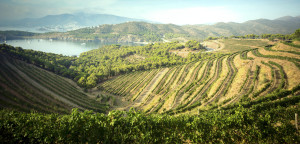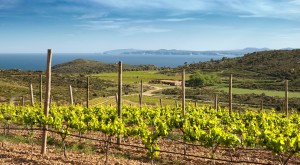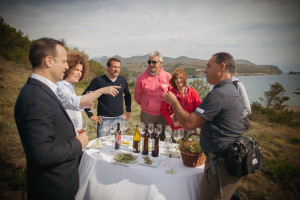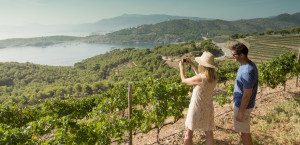Today we have a guest post from Laura Masramon. Ms. Masramon is a personal sommelier and a member of the DO Empordà Wine Route. This is the second part of our two-part series on the wines of the Empordà DO, located on the Mediterranean Coast in Spain’s Costa Brava (Catlonia). Click here to read the first part of the series: The Ancient History of the Empordà Wine Region.
After the phylloxera crisis, it took several generations—until the 1930s—for wine-growing in Empordà to begin once again. In the early days, the farmers were hard-pressed for money and had to join forces. This was the origin of the local wine and olive oil cooperatives, some of which are still in operation today and open to public, such as the Celler Cooperatiu d’Espolla (1931), Empordàlia (1947) and Cooperativa Agrícola de Garriguella (1963).
The tourists arrive: With the arrival of the tourist boom in the 1960s, many farmers decided to move to the coast and go into tourism. They left the countryside to create a first-rate tourist destination, the Costa Brava.
Charming restaurants and hotels were built to attract visitors. Nowadays Empordà gastronomy is famous all over the world. Restaurants like El Bulli, run by chef Ferran Adrià, revolutionised modern cuisine for over two decades. Another reference in the area is El Celler de Can Roca (designated “Best Restaurant in the World” in 2013 and 2015 by the British magazine Restaurant. In fact, the province of Girona boasts the highest number of Michelin stars per capita. The best way to enjoy Empordà wines is with the local gastronomy.
Beginning in the 1990s, a group of young wine experts returned to the farms. Their grandfathers had preserved very old vines, some of which were over a hundred years old. The new generations used these vines and their expertise to create unique, authentic wines. At present their wines are on their way to excellence.
These young oenologists seek to revive the regional varieties to the point of mastering them and understanding them in depth. Thus they obtain wines that express the terroir of the Empordà. They are modern wines but at the same time they speak to us of those 2,700 years of history. Some wineries opt for classic fermentations in stainless-steel vats with ageing in 225-litre and 300-litre oak casks and finish by leaving the wine to rest in bottles with natural corks. Other wineries experiment with methods of fermentation and ageing in amphoras, biodynamic crops and natural wines.
Tramuntana wines: The DO Empordà is a small area with 2,000 hectares (4,900 acres) of vineyards and some 50 wineries. This part of the country is strongly influenced by a dry wind that comes from the north of Europe, the tramuntana, which batters the vines violently with gusts of up to 120 km (75 miles) per hour. The sea breeze however counteracts its effects and hydrates the grapes, allowing a slower ripening of the fruit and a more balanced vine.
The Empordà DO has a mosaic of different terrains stretching in small vineyards between the Mediterranean Sea and the foothills of the Pyrenees. The soils are predominantly granite and slate, sand and silt. Some vineyards cling to terraces of schists and slate. Others grow on clay, pebbles and gravel. There are vineyards facing north, south, east and west. There are vineyards by the sea, on the Empordà plain or lining the hillsides. In addition to this infinite number of terrains there are a large variety of grapes. The most dominant are Garnacha Blanca, Garnacha Gris, Garnacha Tinta, and Carignan (Mazuelo/Cariñena) , as well as the recently discovered but clearly very old White Carignan (Cariñena Blanca) variety.
The predominant red wines have a bright colour with aromas of ripe fruit; in the mouth they are full-bodied, with round, rich tannins thanks to being aged in barrels. The whites can be light, fresh and perfumed when made with Macabeo or Muscat of Alexandria. They can also be unctuous and warm when made with Garnacha Blanca and Garnacha Gris and fermented in barrels.
Garnatxa de l’Empordà: One of the jewels of Mediterranean culture which has so far been preserved is the traditional Garnatxa de l’Empordà, a natural sweet wine aged by the solera system (that is, in barrels that are never completely emptied, in which successive grape vintages are blended). These wines are exposed to years of oxidative ageing, yet still retain the acidity and sweetness of the grape. They are exquisite wines, with highly concentrated aromas of candied fruits like vine peaches and dried apricots, nuts like almonds and walnuts, roasted aromas like coffee and reductive aromas like honey. In the area there are wine cellars with very old ageing barrels, with the oldest ones dating back to 1860.
The Empordà DO regulatory council was officially recognized in 1975. Come visit!
Laura Masramon is Personal Sommelier and member of the DO Empordà Wine Route. She is also co-director of the wine branding seminars Marca Vi and Vivid Enoconference. More information may be found on her website, Lauramasramon.com.
References/for more information:
Are you interested in being a guest blogger or a guest SWEbinar presenter for SWE? Click here for more information!



